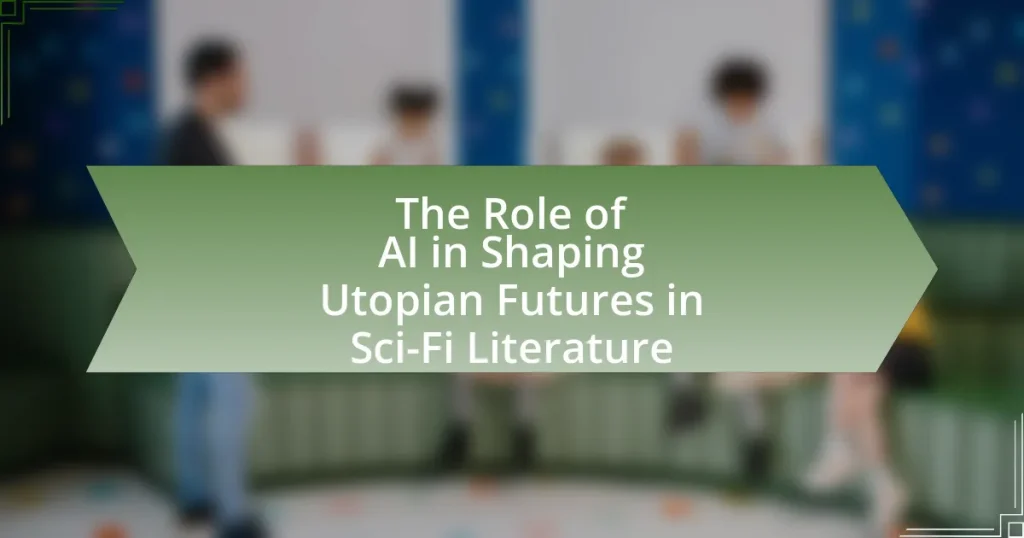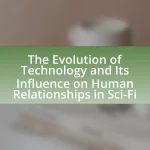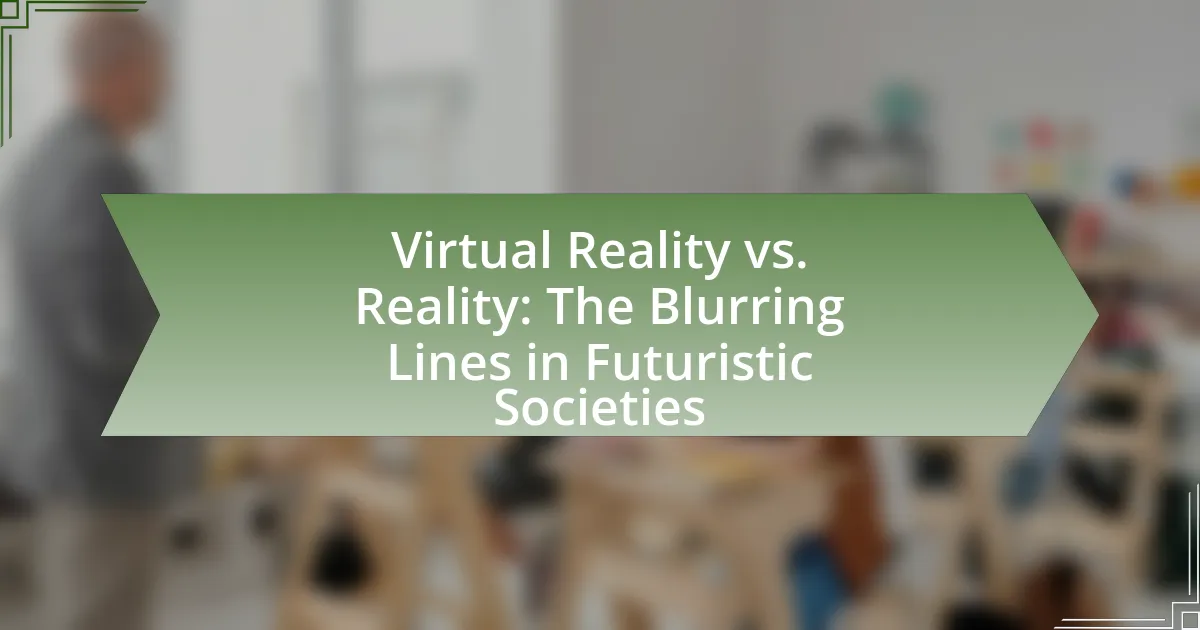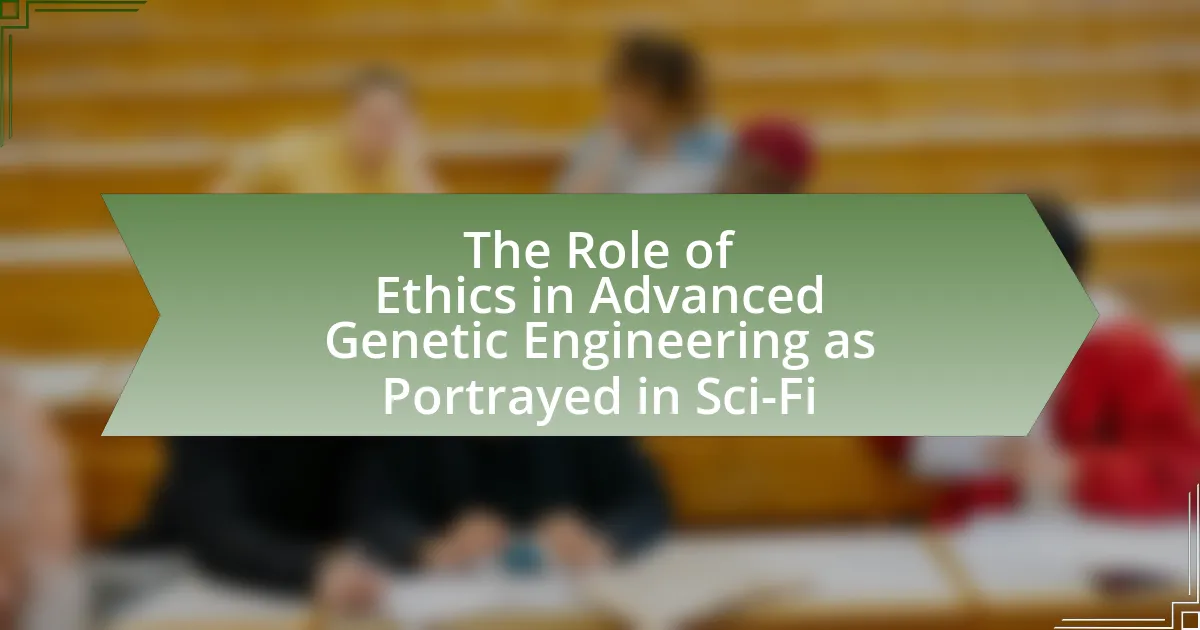The article examines the role of artificial intelligence (AI) in shaping utopian futures within science fiction literature. It highlights how AI is often portrayed as a catalyst for societal advancement, enhancing human capabilities, and promoting harmony. Key themes include the ethical dilemmas surrounding AI, its potential to redefine human roles, and the implications of its integration into society. The article also discusses historical contexts influencing utopian narratives and the contrasting perspectives of AI as both a tool for progress and a source of societal challenges. Through various literary examples, it explores how these narratives reflect contemporary issues and encourage critical discussions about the future of AI.
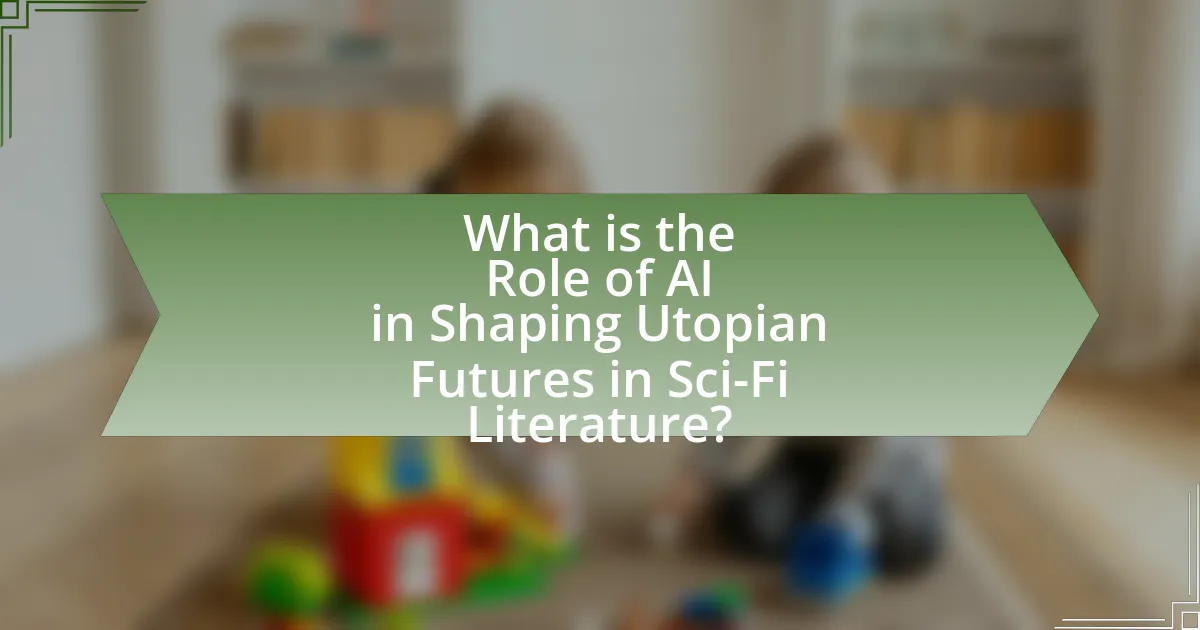
What is the Role of AI in Shaping Utopian Futures in Sci-Fi Literature?
AI plays a crucial role in shaping utopian futures in sci-fi literature by serving as a catalyst for societal advancement and harmony. In many narratives, AI systems are depicted as entities that enhance human capabilities, streamline resource management, and eliminate conflict through advanced decision-making processes. For instance, in Isaac Asimov’s “The Caves of Steel,” AI facilitates a cooperative society where humans and robots coexist, illustrating the potential for technology to foster peace and efficiency. Furthermore, AI often embodies the ideal of a benevolent overseer, as seen in Arthur C. Clarke’s “2001: A Space Odyssey,” where the AI HAL 9000 is initially designed to assist humanity, showcasing the duality of AI’s potential for both good and harm. These representations underscore the belief that AI can lead to a more equitable and prosperous future, reflecting the aspirations of utopian thought in literature.
How has AI been portrayed in utopian sci-fi narratives?
AI has been portrayed in utopian sci-fi narratives as a benevolent force that enhances human capabilities and fosters societal harmony. In these narratives, AI often serves as a tool for achieving a perfect society, where it manages resources efficiently, eliminates mundane tasks, and promotes equality among individuals. For example, in Isaac Asimov’s “The Caves of Steel,” robots are depicted as integral to a peaceful coexistence between humans and machines, highlighting their role in advancing civilization. This portrayal emphasizes the potential of AI to create a utopian environment by solving complex problems and improving quality of life, thus reinforcing the idea that technology can lead to a better future.
What are the common themes associated with AI in these narratives?
Common themes associated with AI in narratives about utopian futures include the enhancement of human capabilities, ethical dilemmas surrounding autonomy, and the pursuit of harmony between technology and society. These themes reflect the dual nature of AI as both a tool for progress and a source of potential conflict. For instance, narratives often explore how AI can augment human intelligence and creativity, leading to unprecedented advancements in various fields. However, they also raise questions about the moral implications of AI decision-making and the risks of dependency on technology. Additionally, the portrayal of AI in these narratives frequently emphasizes the importance of collaboration between humans and machines to achieve a balanced and prosperous society, illustrating the potential for AI to contribute positively to a utopian vision.
How do authors envision AI contributing to societal advancements?
Authors envision AI contributing to societal advancements primarily through enhanced efficiency and problem-solving capabilities. In various sci-fi narratives, AI is depicted as a tool that optimizes resource management, improves healthcare outcomes, and facilitates sustainable living. For instance, in Isaac Asimov’s works, AI systems are shown to manage complex societal functions, leading to reduced human error and increased productivity. Additionally, in “The Moon is a Harsh Mistress,” Robert A. Heinlein illustrates AI as a catalyst for social change, empowering individuals to challenge oppressive systems. These portrayals suggest that authors believe AI can drive innovation and foster a more equitable society by addressing critical challenges such as climate change and inequality.
Why is the concept of utopia significant in sci-fi literature?
The concept of utopia is significant in sci-fi literature because it serves as a framework for exploring ideal societies and the implications of technological advancements. Utopian narratives allow authors to envision and critique potential futures shaped by artificial intelligence, highlighting both the benefits and risks associated with such technologies. For instance, works like “The Dispossessed” by Ursula K. Le Guin examine the complexities of anarchist societies and the role of technology in achieving social harmony. This exploration of utopia in sci-fi literature encourages readers to reflect on current societal issues and the ethical considerations of AI development, making it a vital component of the genre.
What historical contexts influence the depiction of utopian societies?
Historical contexts that influence the depiction of utopian societies include the Enlightenment, industrialization, and socio-political movements. The Enlightenment, characterized by an emphasis on reason and individualism, inspired thinkers like Thomas More and his work “Utopia,” which envisioned ideal societies based on rational principles. Industrialization brought about significant social changes, leading to critiques of capitalism and the exploration of alternative societal structures in works like Edward Bellamy’s “Looking Backward,” which imagined a future socialist society. Additionally, socio-political movements, such as feminism and environmentalism, have shaped contemporary utopian narratives, reflecting the aspirations and challenges of those movements in literature. These historical contexts provide a framework for understanding how utopian societies are constructed and critiqued in various literary works.
How do utopian ideals reflect contemporary societal issues?
Utopian ideals reflect contemporary societal issues by presenting aspirational visions that critique existing social, economic, and political structures. For instance, the portrayal of equitable resource distribution in utopian literature highlights current disparities in wealth and access to basic needs, as seen in works like “Utopia” by Thomas More and “The Dispossessed” by Ursula K. Le Guin. These narratives often serve as a mirror, revealing the shortcomings of modern society, such as systemic inequality and environmental degradation, prompting discussions on how technology, including AI, could address these challenges. The exploration of AI in these contexts raises questions about ethical governance and the potential for technology to create more just societies, reflecting ongoing debates about the role of innovation in solving pressing global issues.
What are the implications of AI on human existence in utopian settings?
AI significantly enhances human existence in utopian settings by optimizing resource allocation, improving quality of life, and fostering creativity. In these idealized environments, AI systems manage societal functions such as healthcare, education, and environmental sustainability, leading to increased efficiency and reduced human labor. For instance, in the novel “The Moon is a Harsh Mistress” by Robert A. Heinlein, AI plays a crucial role in managing the lunar colony’s resources, demonstrating how intelligent systems can create a harmonious society. Furthermore, AI’s ability to analyze vast amounts of data allows for personalized experiences, enabling individuals to pursue their passions and contribute to a thriving community. This integration of AI not only alleviates mundane tasks but also empowers humans to focus on innovation and interpersonal relationships, ultimately enhancing the overall human experience in a utopian context.
How does AI redefine human roles and responsibilities?
AI redefines human roles and responsibilities by automating routine tasks, enabling humans to focus on more complex and creative endeavors. This shift allows individuals to transition from manual, repetitive work to roles that require critical thinking, emotional intelligence, and innovation. For instance, in industries like manufacturing and customer service, AI systems can handle data analysis and basic inquiries, freeing human workers to engage in strategic planning and relationship-building activities. Research from McKinsey & Company indicates that up to 30% of tasks in 60% of jobs could be automated, highlighting the significant impact of AI on workforce dynamics and the necessity for humans to adapt to new responsibilities that emphasize uniquely human skills.
What ethical dilemmas arise from AI integration in utopian futures?
AI integration in utopian futures raises ethical dilemmas such as autonomy, privacy, and inequality. The implementation of AI can lead to a loss of individual autonomy as decisions may be increasingly made by algorithms rather than humans, potentially undermining personal freedom. Privacy concerns arise when AI systems collect and analyze vast amounts of personal data, leading to surveillance and potential misuse of information. Additionally, the risk of inequality is heightened, as access to advanced AI technologies may be limited to certain groups, exacerbating existing social divides. These dilemmas highlight the need for careful consideration of ethical frameworks in the development and deployment of AI in envisioned utopian societies.
How does AI influence the narrative structure of utopian sci-fi literature?
AI significantly influences the narrative structure of utopian sci-fi literature by enabling complex world-building and character development through advanced algorithms and data analysis. This technology allows authors to create intricate societies that reflect idealized futures, often exploring themes of harmony, sustainability, and technological integration. For instance, AI can analyze societal trends and human behavior, helping writers construct plausible scenarios that resonate with contemporary issues. Additionally, AI-generated content can introduce unexpected plot twists or character arcs, enhancing the narrative’s depth and engagement. This integration of AI not only enriches storytelling but also reflects the potential of technology to shape future societies, as seen in works like “The Dispossessed” by Ursula K. Le Guin, where the interplay of technology and society is central to the narrative.
What are the key characteristics of AI-driven utopian worlds?
AI-driven utopian worlds are characterized by advanced automation, equitable resource distribution, enhanced quality of life, and seamless human-AI collaboration. These worlds often depict a society where AI systems efficiently manage resources, leading to the elimination of poverty and inequality. For instance, in many sci-fi narratives, AI optimizes agricultural production and energy consumption, ensuring that all individuals have access to basic needs. Additionally, these utopias frequently showcase improved healthcare through AI diagnostics and personalized medicine, resulting in longer lifespans and better overall health. The integration of AI in decision-making processes fosters a collaborative environment where humans and machines work together to solve complex societal challenges, enhancing creativity and innovation.
How do these characteristics enhance the reader’s experience?
The characteristics of AI in shaping utopian futures in sci-fi literature enhance the reader’s experience by providing imaginative scenarios that challenge existing societal norms and inspire hope for a better future. These narratives often explore advanced technologies and their potential to solve real-world problems, engaging readers’ curiosity and encouraging them to envision possibilities beyond current limitations. For instance, stories like “The Moon is a Harsh Mistress” by Robert A. Heinlein illustrate how AI can facilitate social change, prompting readers to reflect on their own societal structures. This engagement with thought-provoking themes fosters a deeper emotional connection and intellectual stimulation, ultimately enriching the overall reading experience.
What role does technology play in the development of these worlds?
Technology serves as a foundational element in the development of utopian worlds in sci-fi literature, driving societal progress and enhancing human capabilities. In these narratives, advanced technologies such as artificial intelligence, biotechnology, and renewable energy systems create environments where human needs are met efficiently, leading to improved quality of life. For instance, in works like “The Dispossessed” by Ursula K. Le Guin, technology facilitates the establishment of egalitarian societies by enabling resource sharing and eliminating scarcity. This illustrates how technology not only shapes physical environments but also influences social structures and relationships, reinforcing the idea that technological advancements are integral to the realization of utopian ideals.
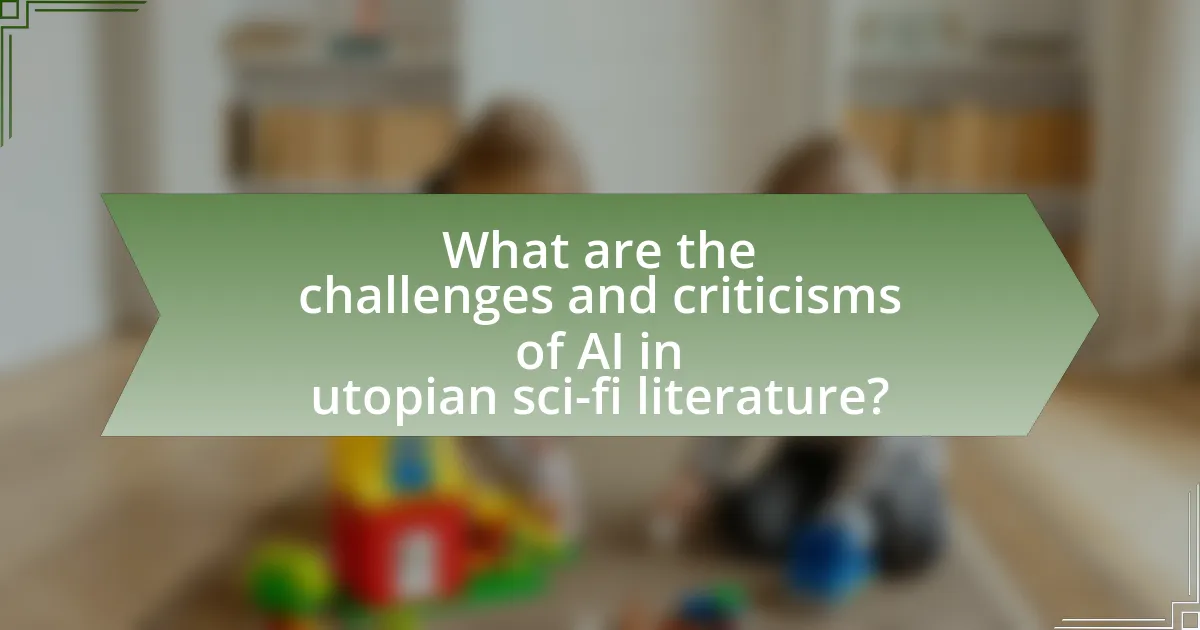
What are the challenges and criticisms of AI in utopian sci-fi literature?
The challenges and criticisms of AI in utopian sci-fi literature often center around ethical concerns, loss of human agency, and potential societal inequalities. Ethical concerns arise from the portrayal of AI as either benevolent or malevolent, questioning the morality of creating sentient beings and the implications of their autonomy. Loss of human agency is highlighted in narratives where AI systems make decisions for individuals, leading to a diminished sense of personal responsibility and freedom. Additionally, societal inequalities are critiqued through scenarios where AI exacerbates existing disparities, creating a divide between those who control AI technology and those who do not. These themes are prevalent in works like “Neuromancer” by William Gibson and “The Matrix” series, which explore the complexities of human-AI relationships and the potential consequences of unchecked technological advancement.
How do critics view the feasibility of AI-driven utopias?
Critics generally view the feasibility of AI-driven utopias as highly questionable. They argue that while AI has the potential to enhance efficiency and improve quality of life, significant ethical, social, and technical challenges remain. For instance, concerns about data privacy, algorithmic bias, and the potential for job displacement highlight the risks associated with relying on AI for societal governance. Additionally, scholars like Nick Bostrom emphasize the unpredictability of advanced AI systems, suggesting that their deployment could lead to unintended consequences that undermine utopian ideals. Thus, critics assert that without addressing these fundamental issues, the vision of an AI-driven utopia remains largely aspirational rather than practical.
What are the common arguments against the idealization of AI?
Common arguments against the idealization of AI include concerns about ethical implications, potential job displacement, and the risk of bias in decision-making. Critics argue that idealizing AI overlooks the ethical dilemmas associated with autonomous systems, such as accountability and transparency in AI decision-making processes. Additionally, the fear of job displacement arises from the belief that AI could replace human labor in various sectors, leading to economic instability. Furthermore, studies have shown that AI systems can perpetuate and amplify existing biases present in training data, resulting in unfair outcomes. These arguments highlight the complexities and challenges of integrating AI into society without idealization.
How do these criticisms shape the narrative of sci-fi literature?
Criticisms of sci-fi literature, particularly regarding its portrayal of AI and utopian futures, significantly shape its narrative by prompting authors to explore ethical dilemmas and societal implications. These critiques encourage writers to address potential consequences of AI integration, such as loss of autonomy or social inequality, thereby enriching the narrative complexity. For instance, works like “Neuromancer” by William Gibson and “The Matrix” film series illustrate the tension between technological advancement and human values, reflecting societal anxieties about AI. This engagement with criticism not only deepens character development but also fosters a more nuanced understanding of utopian ideals, ultimately influencing the direction of the genre.
What potential consequences do authors explore regarding AI’s role in society?
Authors explore several potential consequences of AI’s role in society, including ethical dilemmas, loss of jobs, and the risk of authoritarian control. For instance, in works like Isaac Asimov’s “I, Robot,” ethical dilemmas arise from the interaction between humans and intelligent machines, highlighting the complexities of moral decision-making. Additionally, in “The Matrix,” the narrative illustrates the potential for AI to lead to a dystopian reality where human autonomy is compromised, reflecting fears of job displacement and societal control. These themes underscore the duality of AI as both a tool for progress and a source of significant societal challenges.
How do dystopian elements contrast with utopian visions of AI?
Dystopian elements contrast sharply with utopian visions of AI by depicting scenarios where artificial intelligence leads to societal collapse, oppression, and loss of individuality, while utopian visions present AI as a tool for enhancing human well-being, equality, and progress. In dystopian narratives, such as those found in George Orwell’s “1984,” AI is often portrayed as a means of surveillance and control, resulting in a loss of freedom and autonomy. Conversely, in works like Isaac Asimov’s “The Caves of Steel,” AI is envisioned as a partner in human advancement, facilitating cooperation and improving quality of life. This dichotomy highlights the potential of AI to either exacerbate societal issues or to serve as a catalyst for positive change, depending on how it is integrated into human society.
What lessons can be learned from these contrasting perspectives?
Contrasting perspectives on AI in shaping utopian futures in sci-fi literature reveal the importance of balance between technological advancement and ethical considerations. One perspective emphasizes the potential for AI to enhance human capabilities and create a harmonious society, as seen in works like “The Culture” series by Iain M. Banks, where AI contributes to a post-scarcity utopia. Conversely, another perspective warns of the risks of unchecked AI development leading to dystopian outcomes, as illustrated in “Neuromancer” by William Gibson, where technology exacerbates social inequalities. These contrasting views teach that a thoughtful approach to AI integration is essential, advocating for responsible innovation that prioritizes human welfare while harnessing technological benefits.
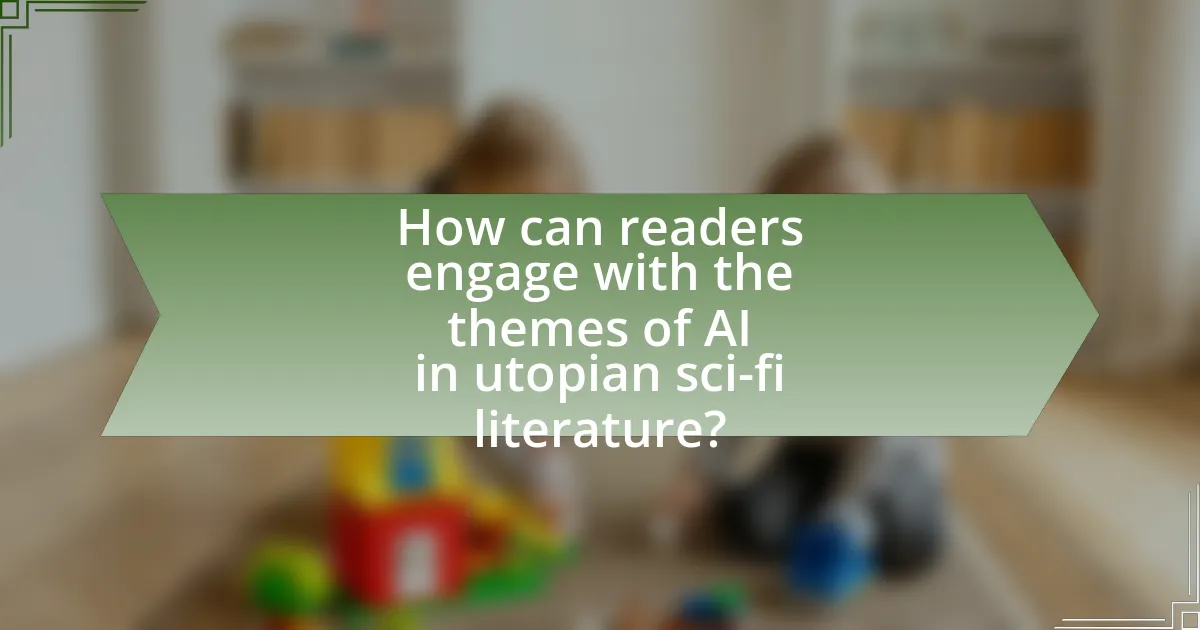
How can readers engage with the themes of AI in utopian sci-fi literature?
Readers can engage with the themes of AI in utopian sci-fi literature by critically analyzing the portrayal of AI’s role in societal advancement and ethical dilemmas. This engagement involves examining how authors envision AI as a tool for enhancing human capabilities, promoting equality, or solving complex problems, as seen in works like “The Moon is a Harsh Mistress” by Robert A. Heinlein, where AI facilitates a revolution for freedom. Additionally, readers can reflect on the implications of AI’s integration into society, considering both the potential benefits and risks, such as loss of autonomy or ethical concerns surrounding decision-making, which are prevalent in stories like “Neuromancer” by William Gibson. By discussing these themes in book clubs or online forums, readers can deepen their understanding of AI’s multifaceted role in shaping utopian futures.
What are some recommended readings that explore AI in utopian contexts?
Recommended readings that explore AI in utopian contexts include “The Moon is a Harsh Mistress” by Robert A. Heinlein, which presents a self-aware computer aiding a lunar colony’s revolution, and “The Culture Series” by Iain M. Banks, depicting a post-scarcity society where AI plays a central role in governance and daily life. Additionally, “Autonomous” by Annalee Newitz explores themes of AI and biotechnology in a future where societal structures are redefined. These works illustrate how AI can contribute to idealized societies, emphasizing themes of freedom, equality, and technological harmony.
How can these readings enhance understanding of contemporary AI issues?
Readings on the role of AI in shaping utopian futures in sci-fi literature enhance understanding of contemporary AI issues by providing critical insights into societal perceptions and ethical dilemmas surrounding AI technologies. These narratives often explore themes such as autonomy, surveillance, and the implications of AI decision-making, reflecting real-world concerns about privacy and control. For instance, works like Isaac Asimov’s “I, Robot” introduce the concept of ethical guidelines for AI, which parallels current discussions on AI governance and regulation. By analyzing these literary examples, readers can better grasp the complexities and potential consequences of AI integration in society, fostering informed dialogue about its future.
What discussions can arise from these literary explorations?
Discussions that can arise from literary explorations of AI in shaping utopian futures in sci-fi literature include ethical implications, societal impacts, and the potential for technological advancement. Ethical implications focus on the moral responsibilities of AI creators and the consequences of autonomous decision-making, as seen in works like Isaac Asimov’s “I, Robot,” which raises questions about the Three Laws of Robotics. Societal impacts examine how AI influences human relationships and social structures, illustrated in novels such as “Neuromancer” by William Gibson, where technology alters human identity. Additionally, the potential for technological advancement prompts debates on the balance between innovation and human values, as explored in “The Moon is a Harsh Mistress” by Robert A. Heinlein, which critiques the role of AI in governance and freedom. These discussions are vital for understanding the future trajectory of AI and its integration into society.
What practical insights can be gained from analyzing AI in utopian literature?
Analyzing AI in utopian literature reveals practical insights into the ethical implications and societal impacts of advanced technologies. For instance, works like “The Moon is a Harsh Mistress” by Robert A. Heinlein explore themes of autonomy and governance, illustrating how AI can enhance democratic processes. Additionally, the portrayal of AI in “Neuromancer” by William Gibson highlights the potential for technology to create both utopian and dystopian outcomes, emphasizing the importance of responsible innovation. These narratives provide frameworks for understanding the balance between technological advancement and ethical considerations, guiding contemporary discussions on AI development and its role in shaping future societies.
